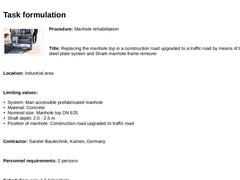
|
(Image: 43192 - Titelbild Dokumentation) Procedure: Manhole rehabilitation Title: Replacing the manhole top in a construction road upgraded to a traffic road by means of the SS-01 steel plate system and Shark manhole frame remover Location: Industrial area Limiting values: - System: Man accessible prefabricated manhole
- Material: Concrete
- Nominal size: Manhole top DN 625
- Shaft depth: 2.0 - 2.5 m
- Position of manhole: Construction road upgraded to traffic …
|
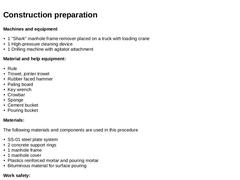
|
Machines and equipment - 1 "Shark" manhole frame remover placed on a truck with loading crane
- 1 High-pressure cleaning device
- 1 Drilling machine with agitator attachment
Material and help equipment: - Rule
- Trowel, jointer trowel
- Rubber faced hammer
- Paling board
- Key wrench
- Crowbar
- Sponge
- Cement bucket
- Pouring bucket
Materials: The following materials and components are used in this procedure - SS-01 steel plate system
- 2 concrete support rings
- 1 manhole frame
|
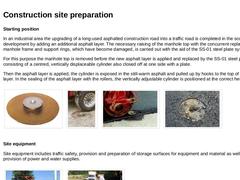
|
Starting position In an industrial area the upgrading of a long-used asphalted construction road into a traffic road is completed in the scope of development by adding an additional asphalt layer. The necessary raising of the manhole top with the concurrent replacement of the manhole frame and support rings, which have become damaged, is carried out with the aid of the SS-01 steel plate system. For this purpose the manhole top is removed before the … |
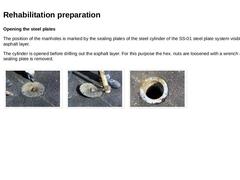
|
Opening the steel plates The position of the manholes is marked by the sealing plates of the steel cylinder of the SS-01 steel plate system visible in the asphalt layer. The cylinder is opened before drilling out the asphalt layer. For this purpose the hex. nuts are loosened with a wrench and the sealing plate is removed. | (Image: Opening the cylinder of the SS-01 steel plate system) |
(Image: Opening the cylinder of the SS-01 steel plate system) |
(Image: … |
|
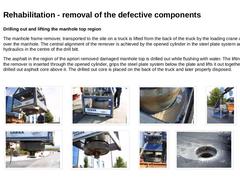
|
Drilling out and lifting the manhole top region The manhole frame remover, transported to the site on a truck is lifted from the back of the truck by the loading crane and positioned over the manhole. The central alignment of the remover is achieved by the opened cylinder in the steel plate system and the lifting hydraulics in the centre of the drill bitt. The asphalt in the region of the apriori removed damaged manhole top is drilled out while flushing … |
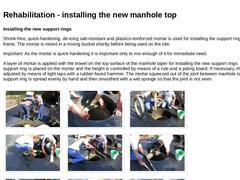
|
Installing the new support rings Shrink-free, quick-hardening, de-icing salt-resistant and plastics-reinforced mortar is used for installing the support ring and manhole frame. The mortar is mixed in a mixing bucket shortly before being used on the site. Important: As the mortar is quick-hardening it is important only to mix enough of it for immediate need. A layer of mortar is applied with the trowel on the top surface of the manhole taper for installing … |

|
After installing the new manhole frame, the manhole invert is cleaned manually of any asphalt or mortar remains that may have dropped into it during the repair work. The site is cleared. The road surface can be used again approximately 1 hour after the installation of the manhole top. |
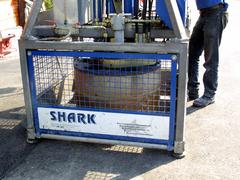
|
Repair of manhole top by replacement by means of steel plate system SS-01 and Shark manhole frame remover machine. |
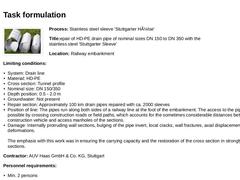
|
(Image: 19347 - Titelbild Dokumentation) Process: Stainless steel sleeve 'Stuttgarter Hülse' Title:epair of HD-PE drain pipe of nominal sizes DN 150 to DN 350 with the
stainless steel 'Stuttgarter Sleeve' Location: Railway embankment Limiting conditions: - System: Drain line
- Material: HD-PE
- Cross section: Tunnel profile
- Nominal size: DN 150/350
- Depth position: 0.5 - 2.0 m
- Groundwater: Not present
- Repair section: Approximately 100 km drain pipes repaired …
|
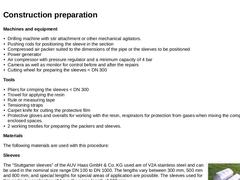
|
Machines and equipment - Drilling machine with stir attachment or other mechanical agitators.
- Pushing rods for positioning the sleeve in the section
- Compressed air packer suited to the dimensions of the pipe or the sleeves to be positioned
- Power generator
- Air compressor with pressure regulator and a minimum capacity of 4 bar
- Camera as well as monitor for control before and after the repairs
- Cutting wheel for preparing the sleeves < DN 300
Tools |
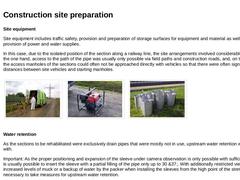
|
Site equipment Site equipment includes traffic safety, provision and preparation of storage surfaces for equipment and material as well as the provision of power and water supplies. In this case, due to the isolated position of the section along a railway line, the site arrangements involved considerable effort. On the one hand, access to the path of the pipe was usually only possible via field paths and construction roads, and, on the other hand, … |
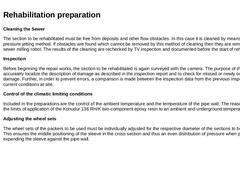
|
Cleaning the Sewer The section to be rehabilitated must be free from deposits and other flow obstacles. In this case it is cleaned by means of the high-pressure jetting method. If obstacles are found which cannot be removed by this method of cleaning then they are removed using a sewer milling robot. The results of the cleaning are rechecked by TV inspection and documented before the start of rehabilitation. Inspection Before beginning the repair works, … |
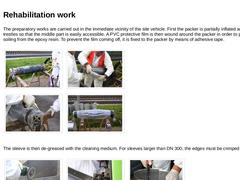
|
The preparatory works are carried out in the immediate vicinity of the site vehicle. First the packer is partially inflated and placed on trestles so that the middle part is easily accessible. A PVC protective film is then wound around the packer in order to protect it from soiling from the epoxy resin. To prevent the film coming off, it is fixed to the packer by means of adhesive tape. | (Image: Packer on the trestles) | (Image: Winding the packer … |
|

|
After positioning the sleeve, the camera and the packer are removed from the section and prepared for the next use. |
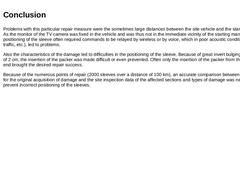
|
Repair of PE-HD drain pipe of nominal sizes DN 150 to DN 350 with the stainless steel 'Stuttgarter Sleeve' - Conclusion |
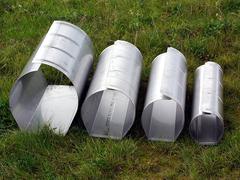
|
Repair of HDPE drain pipes of nominal diameters DN 150 to DN 350 with the stainless-steel sleeve "Stuttgarter Hülse." |
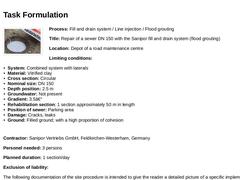
|
(Image: 19292 - Titelbild Dokumentation) Process: Fill and drain system / Line injection / Flood grouting Title: Repair of a sewer DN 150 with the Sanipor fill and drain system (flood grouting) Location: Depot of a road maintenance centre Limiting conditions: - System: Combined system with laterals
- Material: Vitrified clay
- Cross section: Circular
- Nominal size: DN 150
- Depth position: 2.5 m
- Groundwater: Not present
- Gradient: 3.5‰
- Rehabilitation section: …
|
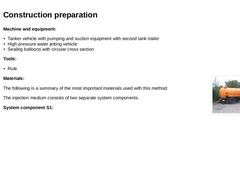
|
Machine and equipment: - Tanker vehicle with pumping and suction equipment with second tank trailer
- High pressure water jetting vehicle
- Sealing balloons with circular cross section
Tools: (Image: Tanker vehicle with tank trailer)
Materials: The following is a summary of the most important materials used with this method: The injection medium consists of two separate system components. System component S1: |
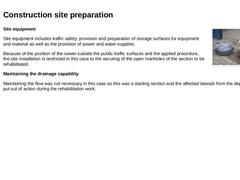
|
(Image: Securing the last manhole of the section to be rehabilitated) Site equipment Site equipment includes traffic safety, provision and preparation of storage surfaces for equipment and material as well as the provision of power and water supplies. Because of the position of the sewer outside the public traffic surfaces and the applied procedure, the site installation is restricted in this case to the securing of the open manholes of the section … |
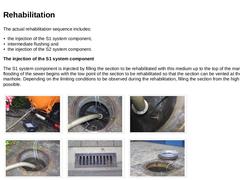
|
The actual rehabilitation sequence includes: - the injection of the S1 system component,
- intermediate flushing and
- the injection of the S2 system component.
The injection of the S1 system component The S1 system component is injected by filling the section to be rehabilitated with this medium up to the top of the manhole. The flooding of the sewer begins with the low point of the section to be rehabilitated so that the section can be vented at the upper … |

|
Leaktightness testing As the final hardening, according to the manufacturer's information, is only reached between 70 hours and a week, the final leaktightness testing to check the success of the rehabilitation is only carried out after this period. |
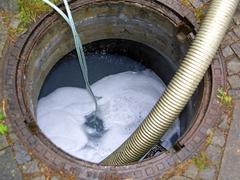
|
Repair of a sewer DN 150 by the Sanipor fill and drain system (flood grouting). |